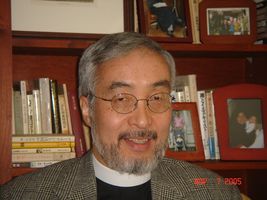Kodera, T.: Difference between revisions
No edit summary |
No edit summary |
||
| (One intermediate revision by the same user not shown) | |||
| Line 5: | Line 5: | ||
|pagename=Kodera, T. | |pagename=Kodera, T. | ||
|PersonType=Authors of English Works; Professors | |PersonType=Authors of English Works; Professors | ||
|images=File:Kodera Takahashi James The Wellesley News.jpg | |||
|MainNamePhon=Takashi James Kodera | |MainNamePhon=Takashi James Kodera | ||
|email=jkodera@wellesley.edu | |email=jkodera@wellesley.edu | ||
| Line 12: | Line 13: | ||
At Wellesley, he helped develop Japanese Studies as part of East Asian Studies Program and Asian American Studies as part of American Studies. | At Wellesley, he helped develop Japanese Studies as part of East Asian Studies Program and Asian American Studies as part of American Studies. | ||
Earlier research focused on individuals and issues in East Asian Buddhism, especially in the Ch’an/Zen tradition. Kodera has written on the place and the role of Christianity in East Asia, including the Jesuits in the 16th century and Uchimura Kanzo. More recently, his research has focused on the plight of “Untouchables” in India (Dalits) and Japan (Burakumin). He is in an early stage of research on Nagasaki from Francis Xavier, who arrived in Nagasaki in 1549, and Takashi Nagai, affected by radiation after the atomic bomb and yet turned Nagasaki into the “City of Prayer” as it remains today, in contrast to Hiroshima. ([http://rippleffectne.com/speaker/t-james-kodera/Source | Earlier research focused on individuals and issues in East Asian Buddhism, especially in the Ch’an/Zen tradition. Kodera has written on the place and the role of Christianity in East Asia, including the Jesuits in the 16th century and Uchimura Kanzo. More recently, his research has focused on the plight of “Untouchables” in India (Dalits) and Japan (Burakumin). He is in an early stage of research on Nagasaki from Francis Xavier, who arrived in Nagasaki in 1549, and Takashi Nagai, affected by radiation after the atomic bomb and yet turned Nagasaki into the “City of Prayer” as it remains today, in contrast to Hiroshima. ([http://rippleffectne.com/speaker/t-james-kodera/ Source Accessed May 7, 2020]) | ||
|affiliation=Wellesley College | |affiliation=Wellesley College | ||
|phduniversity=Ph.D., Columbia University | |phduniversity=Ph.D., Columbia University | ||
Latest revision as of 12:52, 24 July 2020
| PersonType | Category:Authors of English Works Category:Professors |
|---|---|
| MainNamePhon | Takashi James Kodera |
| bio | Jim Kodera is committed to the academic study of religion from the historical and comparative perspective, with a focus on Asia, broadly including both East Asia and South Asia. More specifically, he offers courses on Buddhism from its origin in India through its development in Tibet, China, Korea, Japan and the West and is also interested in the inner relationship between a contemplative life and social and political responsibility, involving a variety of religious and cultural traditions.
At Wellesley, he helped develop Japanese Studies as part of East Asian Studies Program and Asian American Studies as part of American Studies. Earlier research focused on individuals and issues in East Asian Buddhism, especially in the Ch’an/Zen tradition. Kodera has written on the place and the role of Christianity in East Asia, including the Jesuits in the 16th century and Uchimura Kanzo. More recently, his research has focused on the plight of “Untouchables” in India (Dalits) and Japan (Burakumin). He is in an early stage of research on Nagasaki from Francis Xavier, who arrived in Nagasaki in 1549, and Takashi Nagai, affected by radiation after the atomic bomb and yet turned Nagasaki into the “City of Prayer” as it remains today, in contrast to Hiroshima. (Source Accessed May 7, 2020) |
| affiliation | Wellesley College |
| phduniversity | Ph.D., Columbia University |
| education | Ph.D., Columbia University
B.A., Carleton College; M.A., M.Phil. |
| IsInGyatsa | No |
| Other wikis |
If the page does not yet exist on the remote wiki, you can paste the tag |
